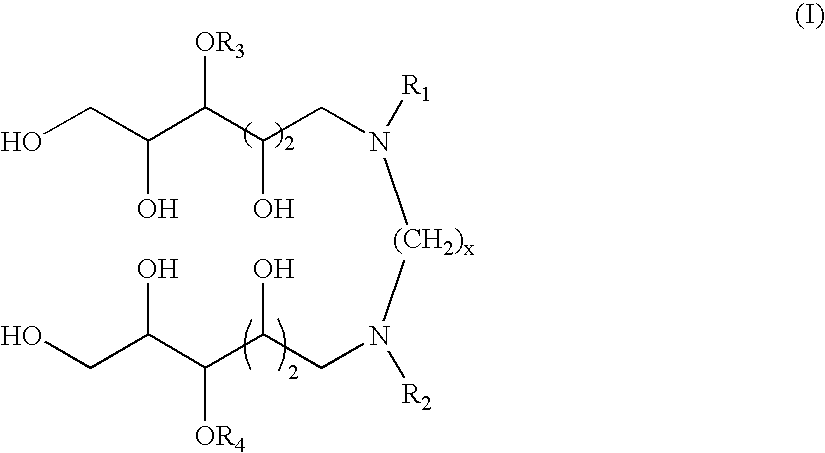N,N'-dialkyl derivatives of polyhydroxyalkyl alkylenediamines
a technology of alkylenediamine and dimethyl ether, which is applied in the field of n, n'-dialkyln, n'-bis (polyhydroxyalkyl) alkylenediamine, can solve the problems of undesirable foaming
- Summary
- Abstract
- Description
- Claims
- Application Information
AI Technical Summary
Problems solved by technology
Method used
Image
Examples
examples
[0052] Examples 1-7 illustrate one particularly suitable process for preparing compounds according to the invention, via coupling of a 1-deoxy-1-(alkylamino)-D-glucitol or mixture of 1-deoxy-1-(alkylamino)-D-glucitols with glyoxal in the presence of a catalyst at elevated temperature and pressure of hydrogen. This transformation is represented by the following equation:
The preparation of N,N′-dioctyl-N,N′-bis(1-deoxyglucityl)ethylenediamine is used for illustration.
examples 1-7
[0053] A 100 mL Parr stainless steel reactor was charged with 2.93 gm (0.01 mole) 1-deoxy-1-(octylamino)-D-glucitol, 0.70 gm of 40% aqueous glyoxal (0.00483 mole; 0.966 equivalent), 0.14 gm (dry weight basis) 5% palladium on carbon, and 30 gm of methanol. The reactor was closed, purged with nitrogen and hydrogen, and pressurized to ca 600 psig with hydrogen. The mixture was heated with stirring (1000 rpm) to 125° C. and pressurized with hydrogen to 1000 psig. The reaction was maintained at this temperature; pressure was maintained at 1000 psig via regulated hydrogen feed. After 12 hr, the mixture was cooled to room temperature, and the product removed from the reactor by filtration through an internal 0.5μ sintered metal element. After trimethylsilylation, analysis of the product by gas chromatography (GC) and gas chromatography / mass spectroscopy (GC-MS) indicated that it consisted of 85% N,N′-dioctyl-N,N′-bis(1-deoxyglucityl)-ethylenediamine, 6% N-octyl-N-(2-hydroxyethyl)-1-deoxygl...
example 8
[0054] This example illustrates another aspect of this invention, the ability to use sugars other than α-D-glucose to prepare surfactants with carbohydrate groups other than 1-deoxyglucityl.
[0055] The procedure of examples 1-7 was followed, with substitution of 4.55 gm (0.01 mole) 1-deoxy-1-(aminooctyl)-D-maltitol in place of the 1-deoxy-1-(aminoalkyl)glucitol used previously. Owing to the high molecular weight of the resulting gemini surfactant, analysis by GC or GC-MS after trimethylsilylation was unsuccessful. However, analysis by MALD / I MS showed that the desired N,N′-dioctyl-N,N′-bis(deoxymaltitol)-ethylenediamine had been formed, along with a lesser amount of N-octyl-N-(2-hydroxyethyl)-1-deoxymaltitol.
TABLE 1N,N′-Dialkyl-N,N′-Bis(1-deoxyglucityl)alkylenediaminesSpacerNBLengthExampleReference(x)R1R2Abbreviation118593-852n-C8H17n-C8H17DODGEDA218838-342n-C6H13n-C6H13DHDGEDA318838-352n-C4H9n-C4H9DBDGEDA418588-47a2n-C8H17n-C4H9BODGEDA518588-462CH3O(CH2)3CH3O(CH2)3MPDGEDA618588-7...
PUM
| Property | Measurement | Unit |
|---|---|---|
| temperature | aaaaa | aaaaa |
| temperature | aaaaa | aaaaa |
| temperatures | aaaaa | aaaaa |
Abstract
Description
Claims
Application Information
 Login to View More
Login to View More - R&D
- Intellectual Property
- Life Sciences
- Materials
- Tech Scout
- Unparalleled Data Quality
- Higher Quality Content
- 60% Fewer Hallucinations
Browse by: Latest US Patents, China's latest patents, Technical Efficacy Thesaurus, Application Domain, Technology Topic, Popular Technical Reports.
© 2025 PatSnap. All rights reserved.Legal|Privacy policy|Modern Slavery Act Transparency Statement|Sitemap|About US| Contact US: help@patsnap.com



